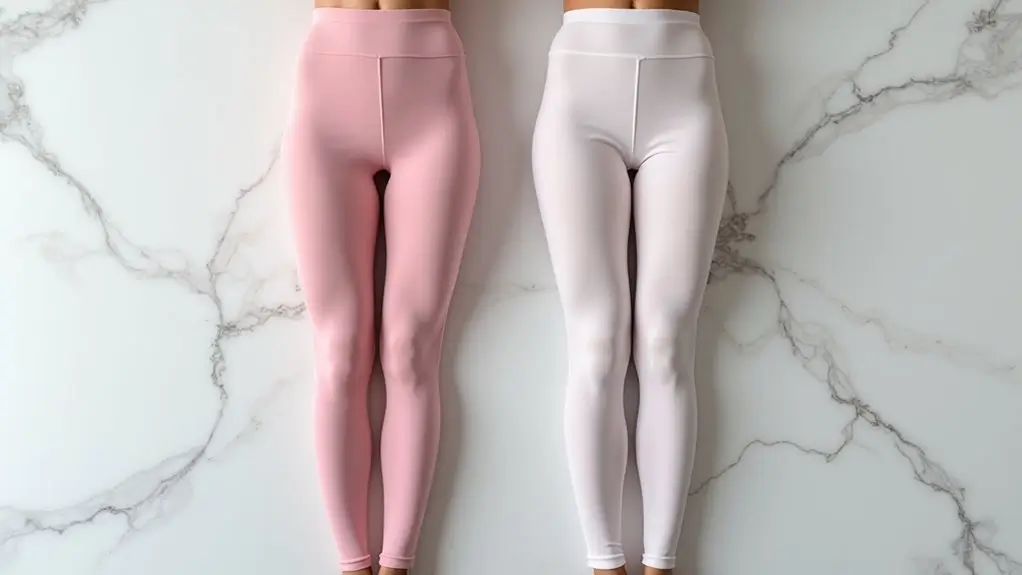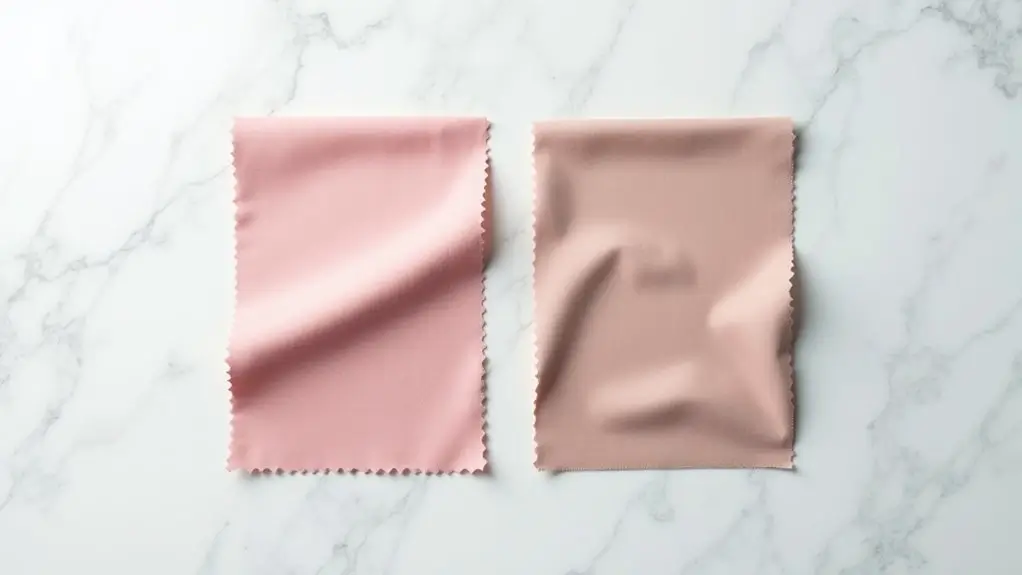Did you notice the "elastane" and "spandex" terms while checking clothing labels? Do you wonder if there's any real difference between them?
These stretch synthetic fibers have revolutionized the textile industry. They're popular for garments like yoga pants and swimwear.
Whether you're shopping in Europe or America, knowing the different names of this important material will help you make better garment choices.
Key Takeaways
- Elastane and spandex are chemically identical fibers. "Elastane" is the European term, and "spandex" is the American term.
- Both materials can stretch up to 500% of their original length without losing shape or structure.
- They're made from polyurethane-polyurea copolymer fibers and typically comprise 2-10% of fabric blends.
- Both terms refer to the same synthetic fiber originally marketed as Lycra by DuPont in 1958.
- These fibers are durable against body oils and sweat while keeping clothing lightweight and comfortable.
Elastane Vs Spandex: Chemically Identical Fibers

Elastane and spandex are identical materials. So, they share all their core characteristics and performance properties.
Both fabrics offer exceptional stretch capabilities. They can return to their original shape after being stretched up to 500%.
They're both synthetic fibers made from polyurethane polymers. They provide durability and resistance to body oils and sweat.
Both of them maintain their elasticity through repeated wear and washing cycles. This makes them ideal for activewear and form-fitting garments.
They also have the same lightweight properties and can be blended with other fibers.
What Is Elastane Fabric or Spandex Fiber?

Elastane, or spandex, is a revolutionary synthetic fiber developed in 1958 by chemist Joseph Shivers at DuPont laboratories. It combines remarkable stretch with excellent recovery properties.
History and Development
In the early 1950s, DuPont started creating synthetic elastic fibers. The company wanted to change how the textile industry made stretchy fabrics.
After several years of research, the first spandex made its debut in 1958, marketed under the brand name Lycra. This breakthrough synthetic fiber was created through a complex polymerization process.
The development of spandex made significant waves in the fashion industry. It offered superior stretch and recovery compared to natural rubber. Spandex quickly became essential in activewear, swimsuits, and form-fitting garments.
Today, manufacturers continue to refine the production process. They've created even more advanced variations of this versatile fiber.
Properties of Spandex
Spandex's most notable characteristic is its exceptional elasticity. This allows it to stretch up to seven times its original length and return to its initial form without losing shape.
The elastane material's durability means you can stretch and release it repeatedly. It can maintain its recovery properties.
You'll also notice elastane's resistance to body oils, sweat, lotions, and detergents. This makes it ideal for activewear and swimsuits.
It's also lightweight and integrates seamlessly with other fibers. It typically comprises only 2-10% of fabric blends.
Common Uses
Modern clothing manufacturers rely heavily on spandex for a wide range of garments.
Elastane fiber is common in activewear, like yoga pants, running shorts, and compression garments. It works well for clothes that need to move with your body during exercise.
Elastane is also vital in everyday clothing, such as jeans, swimwear, and undergarments.
The fiber's ability to stretch and return to its original shape makes it perfect for form-fitting garments.
Additionally, you'll see elastane in medical compression stockings, support garments, and athletic uniforms.
Environmental Impact
Elastane is versatile for clothing. But there are major environmental issues related to its production and disposal processes.
Clothing with elastane doesn't biodegrade like natural fibers. Disposing of spandex will add to landfill waste. The manufacturing process requires petroleum-based materials and intensive chemical treatments. It'll release harmful emissions.
It's also challenging to recycle elastane-containing garments. Because separating it from other fibers is nearly impossible.
Some companies are now developing more sustainable alternatives. But current production continues to have a substantial environmental impact through water pollution and energy consumption.
The synthetic fiber's microplastic shedding also affects marine ecosystems.
Key Differences Between Spandex and Elastane Material
Many people may search for differences between elastane and spandex. But these terms actually refer to the exact same synthetic fiber material.
There's no technical difference between these two materials. The main difference lies in their different names.
You'll find "elastane" used primarily in Europe and parts of Asia. But "spandex" is more common in North America.
Both terms describe a polyether-polyurea copolymer. It's known for its exceptional elasticity and ability to return to its original shape.
The main variation you'll encounter is purely regional naming conventions, not material properties.
Spandex Vs Elastane Vs Lycra
Spandex, Lycra, and elastane are all the same synthetic fibers under different brand names worldwide. In the United States, you'll commonly see it called spandex products. But European countries prefer the term spandex and elastane.
The material is made of polyurethane-polyurea copolymer fibers. They can stretch up to 500% of their original length and return to their shape.
When shopping for activewear or stretchy clothes, you’ll see these terms used the same on labels.
The fiber's exceptional elasticity and durability make it perfect for athletic wear, swimsuits, and form-fitting garments.
Eco-friendly Alternatives for Spandex
Spandex is also known as elastane or Lycra. It's widely used in clothing for its stretchability and comfort. But its production involves significant environmental concerns. Here are some other sustainable fabrics to consider:
1. Organic Cotton:
- Grown without synthetic pesticides or fertilizers.
- Biodegradable and has a lower environmental impact compared to conventional cotton.
- Offers natural stretch and breathability.
2. Recycled Polyester:
- Made from recycled plastic bottles or other polyester garments.
- Reduces waste and conserves resources by repurposing existing materials.
- Retains good elasticity and durability, making it suitable for activewear.
3. Tencel (Lyocell):
- Produced from sustainably sourced wood pulp.
- Uses a closed-loop process that recycles water and solvents.
- Soft, breathable, and has natural stretch properties.
4. Bamboo Fabric:
- Made from bamboo pulp, which is a fast-growing, renewable resource.
- Naturally antibacterial and moisture-wicking.
- Offers a comfortable stretch and is biodegradable.
5. Hemp Fabric:
- Derived from the hemp plant, known for its low environmental impact.
- Naturally strong and durable with good elasticity.
- Biodegradable and requires less water than conventional crops.
6. Natural Rubber:
- Sourced from rubber trees, making it a renewable material.
- Offers excellent stretch and recovery properties.
- Biodegradable and has a lower carbon footprint compared to synthetic alternatives.
7. Recycled Nylon:
- Created from post-consumer waste, such as discarded fishing nets.
- Helps reduce ocean plastic pollution while maintaining good stretch qualities.
- Durable and versatile, suitable for various types of apparel.
These alternatives help reduce environmental impact and promote a more sustainable future. This makes them great options for both manufacturers and consumers.
Conclusion
Elastane and spandex are identical fibers with different regional names. Spandex is used more in North America and elastane in Europe. Both terms are used interchangeably on clothing labels, while Lycra remains a specific brand name.
When shopping for stretchy clothes, you can trust that these terms refer to the same synthetic material.
Learn more fabric knowledge on the Longan Craft Blog, and dive into the fabric world with Longan Craft!
FAQs
Can Elastane and Spandex Fabrics Be Ironed Safely?
You'll need to iron them carefully. Use low heat settings and avoid direct contact. It's best to iron these fabrics inside out and place a pressing cloth between them and the iron.
How Long Does Elastane Maintain Its Stretch Properties?
Regular wear gives you about 6-12 months of ideal stretch from your garments. After that, they'll gradually lose stretchability. You can extend this lifespan with proper care, like cold washing and avoiding heat.
Are Spandex Fabrics Biodegradable?
You won't find these synthetic fibers biodegrading naturally. They're made from polyurethane-polyurea copolymer. It can take hundreds of years to break down. This contributes to long-term environmental concerns in landfills.
What Temperature Should I Wash Clothes Containing Spandex?
You should wash your spandex garments in cool to lukewarm water (30-40°C/85-104°F). Don't use hot water. It'll damage the elastic fibers and reduce their stretch properties.
Can Pregnant Women Safely Wear Clothes Made With Elastane or Spandex?
You can safely wear elastane clothing during pregnancy. These stretchy fabrics will comfortably accommodate your growing belly and provide support. But make sure they're not too tight or restrictive.


0 comments